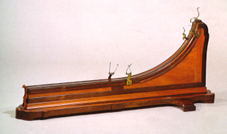
60 x 131.2 x 44.7
Carved wood and brass
INDEX 1788 : G.VI.170
Machina lignea constans partim ex cycloide, partim ex horizontali plano, qua ostenditur corpora in Cycloide semper paribus ferri temporibus ad ejus extremum, quamvis ceciderint ab altitudinibus variis; et Capsa ex variis altitudinibus acquirere velocitates in ratione subduplicata altitudinum.
A machine composed of wood, part in a cycloidal and part in a horizontal plane, by means of which it is shown that bodies in the cycloid are always propelled to the end in similar periods of time even when having fallen from different heights; and that falling from different heights acquire speeds in proportion to the square root of the height.
The movements of two spheres along a cycloid can be studied with this machine, which comprises two identical channels which the spheres move along. The whole body of the apparatus is formed by a vertical wooden platform mounted in a base also of wood. The trajectory that the spheres follow along the channel takes the form of a cycloid extended into a horizontal straight line segment. Along the trajectory, between the two channels there is a brass blade which has reference marks on it which permits the study of the characteristics of the spheres' movements. The cycloid part is divided into 16 unequal parts, increasing in length from the highest point to the point where the cycloid is tangential to the horizontal straight line segment. The straight, horizontal part of the trajectory is divided into 12 equal parts.
Bells were installed in each of the two channels, but only the fixtures where the bells used to be installed remain today. These bells permitted the measurement of the time taken by the movement of the spheres. The apparatus also has two pieces of jointed brass that free the spheres at the start of the movement.
With this machine, it was possible to demonstrate that the descent time of a sphere along the cycloid is always the same, whatever the starting point. To this effect, a sphere was placed in each of the channels at different heights. Releasing them simultaneously, it was possible to verify, through the simultaneous ringing of the bells situated in the two channels, that although they covered different distances, the spheres arrived at the same instant at the lowest point of the cycloid. As the spheres were released from different heights, their velocities are obviously not the same on arrival at the lower point of the cycloid.
Another experiment that could be carried out consisted of a demonstration that the distance travelled through by the two spheres along the straight line trajectory during a determined period of time are inter-related as the square roots of the heights of the release points of the spheres. For this experiment, the two spheres had to be started from different heights at the same time in each of the cycloids. Two bells were placed over the straight line part of the trajectory in positions chosen so that they would ring simultaneously upon the impact of the spheres. Once fixed in these positions, the distance travelled through could be compared to the starting heights of the spheres. It was possible to deduce the following relationship: S1 / S2 = (h1 / h2)1/2, where S1 and S2 represent the distance travelled through in the horizontal portion of the channel and h1 and h2 are the starting heights of the spheres.
From Colégio dos Nobres, catalogue n.º 160.
's Gravesande, Willem Jacob, Physices Elementa, Leiden, 1742, vol. I, p. 402, Tab. XV, fig. 7.
Desaguliers, Jean Théophile, A Course of Experimental Philosophy, London, 1734, vol. I, p. 379, Pl. 27, Fig. 8.